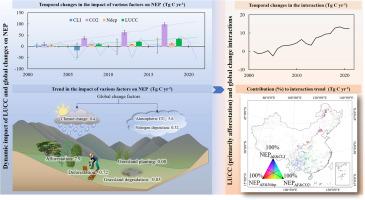Ecosystem engineering and global changes are increasingly enhancing China’s terrestrial carbon sinks
IF 10.9
1区 环境科学与生态学
Q1 ENGINEERING, ENVIRONMENTAL
引用次数: 0
Abstract
Ecosystem engineering-driven land-use change (LUCC) and global changes (climate change, elevated CO2, and nitrogen deposition) profoundly affect net ecosystem productivity (NEP), yet their temporal dynamics remain unclear. Using a process-based model, we evaluated their effects on NEP in China’s ecosystem engineering zones from 2001 to 2021. Results showed an average NEP of 256 Tg C yr-1, increasing at a rate of 11.3 Tg C yr-2, primarily driven by afforestation (effect increasing at 2.9 Tg C yr-2) and elevated CO2 (effect increasing at 5.6 Tg C yr-2)—higher than that of climate change (0.4 Tg C yr–2). LUCC-global change interactions strengthened, contributing 27 % (2001–2010) to 32.1 % (2011–2021) of the LUCC effect, primarily due to increasing CO2 and shifting precipitation. Furthermore, we identified optimal climatic spaces (precipitation: 750–2600 mm, temperature: 10–25 °C) that enhanced interactions. Restricting afforestation to these areas could enhance NEP by 65 %. Our findings highlight afforestation’s persistent carbon sink potential under global change, providing key insights for optimizing sustainable land management.

生态系统工程和全球变化正日益增强中国的陆地碳汇
生态系统工程驱动的土地利用变化(LUCC)和全球变化(气候变化、CO2升高和氮沉降)深刻影响净生态系统生产力(NEP),但其时间动态尚不清楚。利用基于过程的模型,评估了2001 - 2021年中国生态系统工程区新能源政策的影响。结果表明,平均NEP为256 Tg C /年,以11.3 Tg C /年的速率增加,这主要是由造林(效应增加2.9 Tg C /年)和CO2升高(效应增加5.6 Tg C /年)驱动的,高于气候变化(效应增加0.4 Tg C /年)。LUCC-全球变化相互作用增强,贡献了27%(2001-2010)至32.1%(2011-2021)的LUCC效应,主要是由于CO2增加和降水转移。此外,我们确定了增强相互作用的最佳气候空间(降雨量750-2600毫米,温度10-25°C)。在这些地区限制植树造林可使新经济总量提高65%。我们的研究结果强调了全球变化下造林的持续碳汇潜力,为优化可持续土地管理提供了关键见解。
本文章由计算机程序翻译,如有差异,请以英文原文为准。
求助全文
约1分钟内获得全文
求助全文
来源期刊

Resources Conservation and Recycling
环境科学-工程:环境
CiteScore
22.90
自引率
6.10%
发文量
625
审稿时长
23 days
期刊介绍:
The journal Resources, Conservation & Recycling welcomes contributions from research, which consider sustainable management and conservation of resources. The journal prioritizes understanding the transformation processes crucial for transitioning toward more sustainable production and consumption systems. It highlights technological, economic, institutional, and policy aspects related to specific resource management practices such as conservation, recycling, and resource substitution, as well as broader strategies like improving resource productivity and restructuring production and consumption patterns.
Contributions may address regional, national, or international scales and can range from individual resources or technologies to entire sectors or systems. Authors are encouraged to explore scientific and methodological issues alongside practical, environmental, and economic implications. However, manuscripts focusing solely on laboratory experiments without discussing their broader implications will not be considered for publication in the journal.
 求助内容:
求助内容: 应助结果提醒方式:
应助结果提醒方式:


